Looking for Petra, the wild Finnish forest reindeer
With my rucksack weighing heavily on my back, I step from the dirt track onto a stony path. I breathe deeply to absorb the scents of the forest that magically lighten my rucksack and calm my mind. As I walk further, I feel beads of sweat rise on my back. The evening is sunny and hot. To my left side is Koirajärvi lake, in front and on the right is a dry pine forest. I’m in Salamajärvi National Park, where I’ll spend the next 3 days looking for Petra, the wild forest reindeer, or the Finnish reindeer. My hopes to see and photograph a forest reindeer are high, my expectations zero. I have planned a route through the national park using marked paths that weave through likely habitat, to increase my chance of finding and seeing a wild Finnish forest reindeer for the first time in my life.
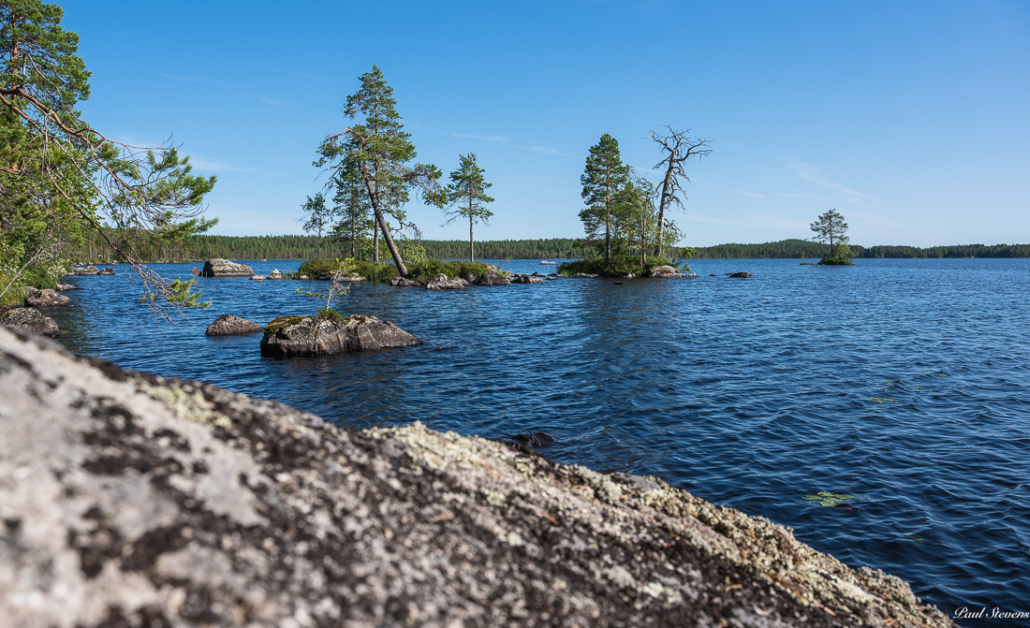
The story of the wild forest reindeer has fascinated me for a long time. Its scientific name, Rangifer tarandus fennicus, refers to its importance in Finnish history. When the glaciers melted and withdrew at the end of the last ice age, the forest reindeer followed the retreating ice edge from their possible refuge in Siberia. Its cousin the tundra reindeer, Rangifer tarandus tarandus, also known as the semi-domesticated reindeer of Lapland, possibly came from ice free regions of Norway. The importance and popularity of forest reindeer is recorded in many place names in Finland, and in the many names the animal has, such as Petra. Early settlers to Finland may have brought the name with them, as Petra is not a Finnish name, but comes from southern Europe.
Forest reindeer were hunted to extinction in Finland at the turn of the 19th and 20th centuries. Fortunately, it wasn’t final as the reindeer still lived in the wild forests of Russian Karelia. In the 1950s, forest reindeer migrated across the border from Russian Karelia to Kuhmo, Finland. The population in Kuhmo grew to a maximum of about 2000 animals, before declining to its current level of just under 1000 reindeer. At the end of the 1970s and start of the 1980s, 8 cows and 2 bulls were moved from Kuhmo to Salamanperä in the Suomenselkä area of Central Finland. Suomenselkä’s current population of about 2,000 individuals stems from those 10 animals and is now quite stable. The forest reindeer is a good example of how tenacious some species can be, and a good example of how humans can correct their earlier mistakes.
The path meanders through the forest, over bogs and across fields of broken rock, or pirunpelto as they are known in Finnish, to Pyydyskoski, where I will spend the night. After setting up my tent and eating some snacks, I walk to the bog that I came through on the way to the campsite. Small, stunted pine trees grow on the bog reducing the chances of seeing a forest reindeer. Still, I keep my eyes peeled for any movement between the trees. As expected, I saw no reindeer just plenty of ripe cloudberry. Now I know where to come to get some fresh, juicy fruit for my porridge in the morning.


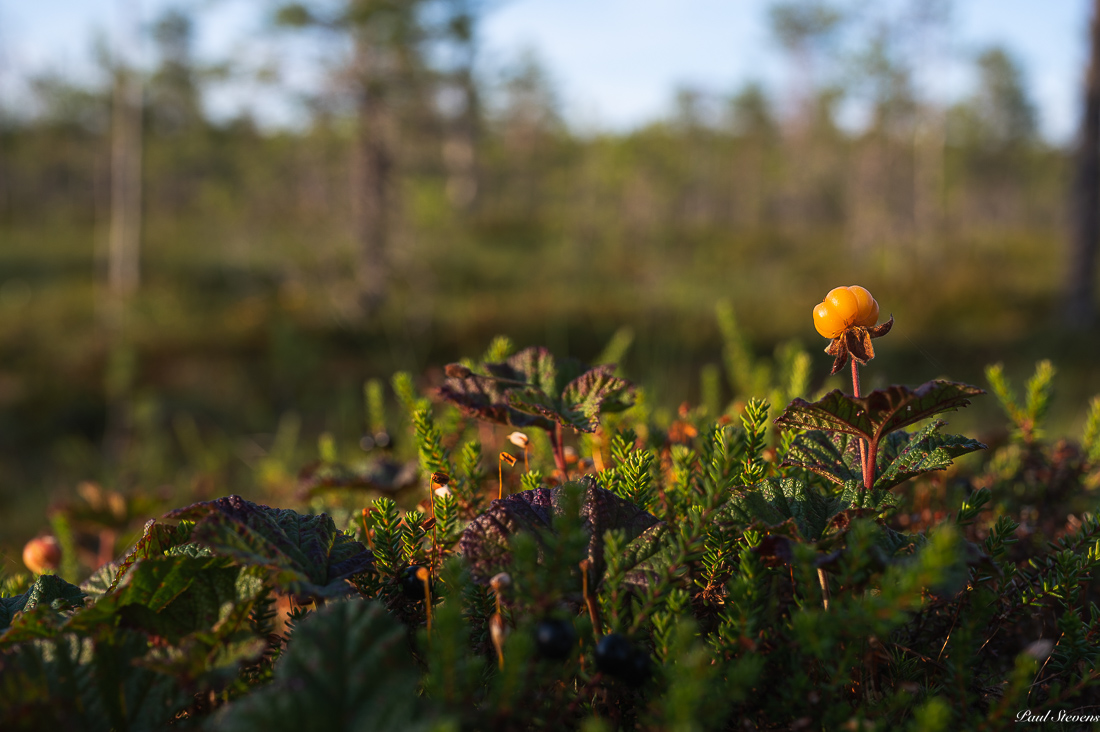
After breakfast on my second day, I start hiking to Sysilampi. I have higher hopes today. The path runs next to the biggest mire in Salamajärvi National Park. At the edge of the mire, there is a nature tower from which I hope to get a glimpse of a forest reindeer. In summer, forest reindeer frequent mires and bogs, from where they find plenty to eat, where they can easily spot predators, and where they can get relief from biting insects. Before the mire, I walk through the forest to the Heikinjärvi rest area. With the sun shining from a clear sky the temperature rises quickly. Sweat once again soaks my back, so it’s a relief to take my rucksack off and let my shirt dry, while I enjoy a cup of coffee with a small snack by the lake.
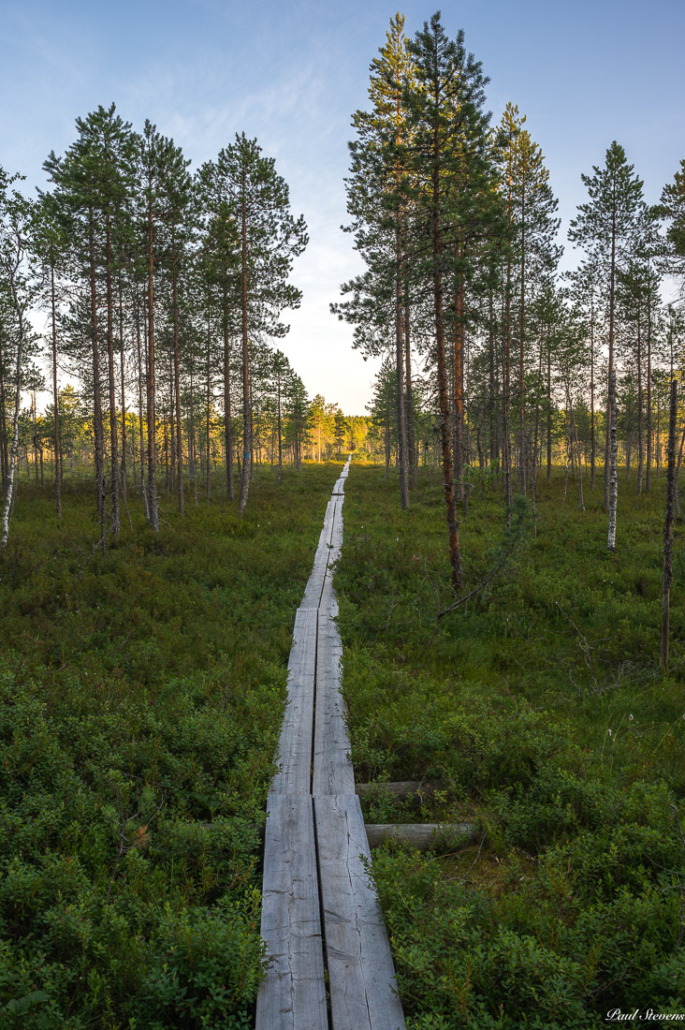
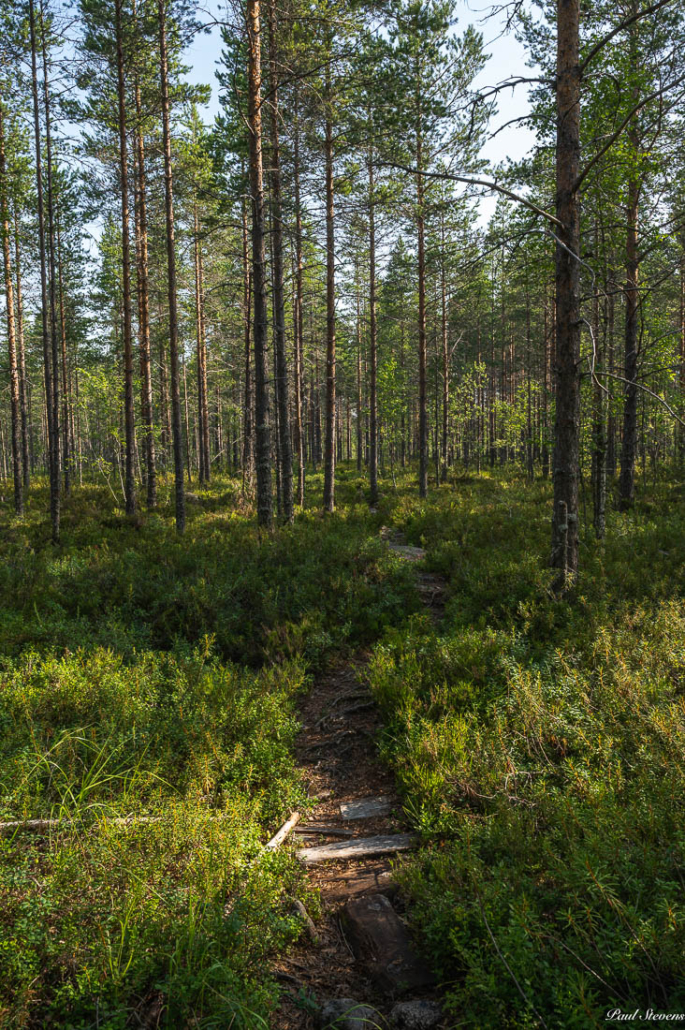
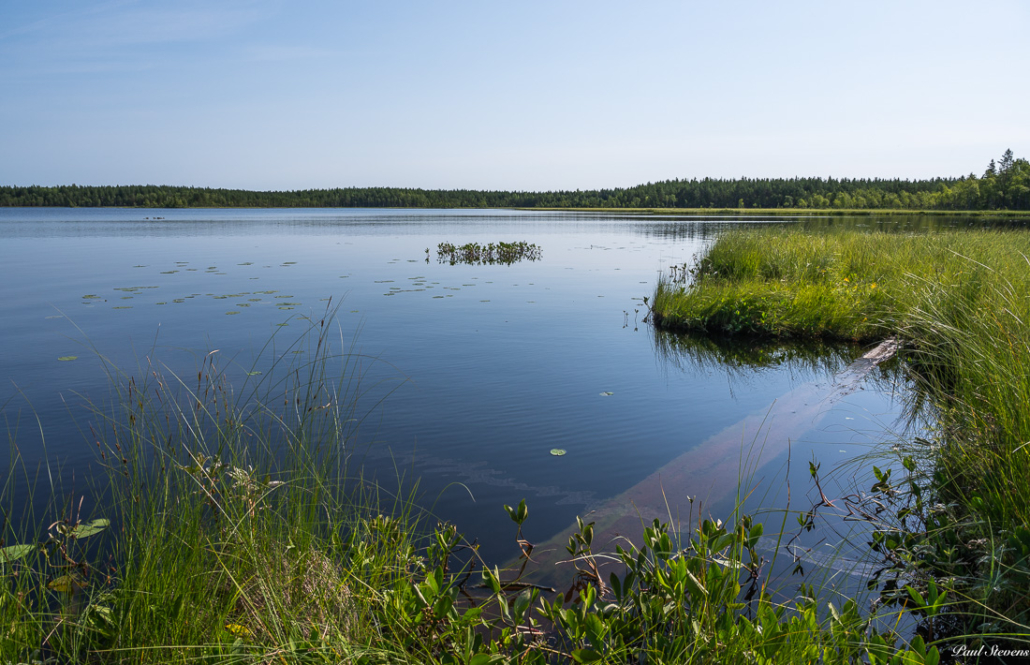
Dry and rested, I continue my journey to the nature tower. Before me an extensive, beautiful aapa mire Heikinjärvi opens out. I look for reindeer on the mire but there is no other life than a few gulls and a pair of whooper swans in the distance. I attach my longer zoom lens to get a better look. There is nothing bigger on the aapa mire than the whooper swans, so I sit down and eat my lunch. Occasionally the wind blows, its coolness feels refreshing on my back, as the sweat evaporates in the breeze. After resting for more than half an hour, I continue my journey to Sysilampi without even a glimpse of a forest reindeer.

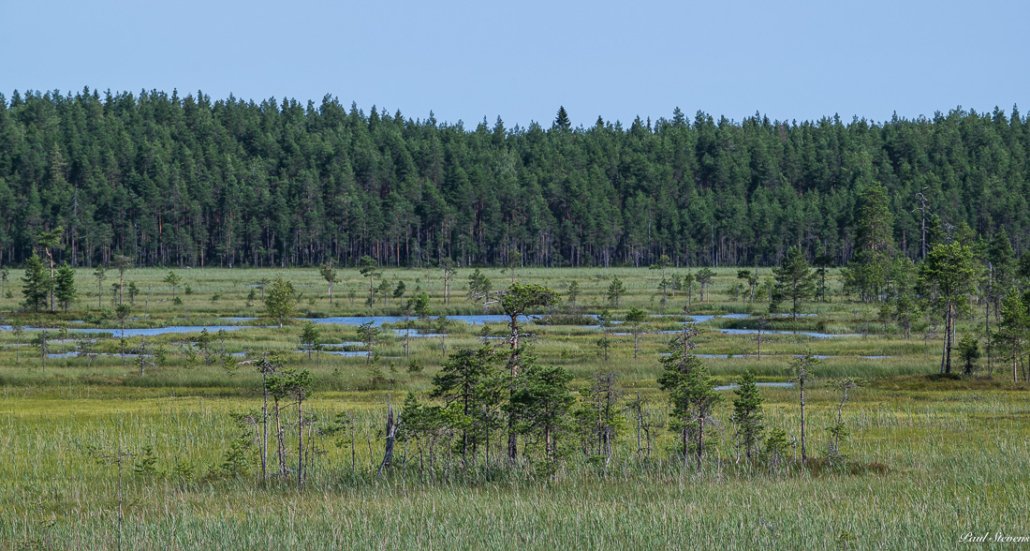
The path winds through the forest, past an old meadow sauna, towards Pakosuo, which will give me a second chance to see a reindeer. As I walk across the bog on the duckboards, I try to search for reindeer without falling off into the waterlogged ground. A couple of times I wobble, but I don’t fall, and I don’t see any reindeer either. Perhaps they are sensibly hiding from the heat somewhere.
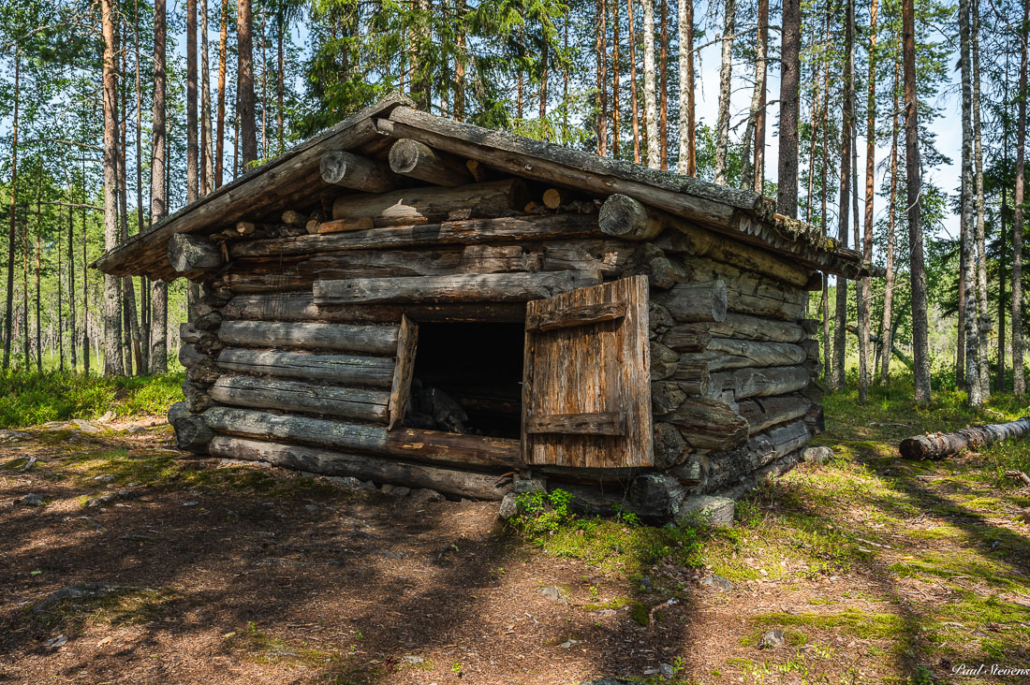
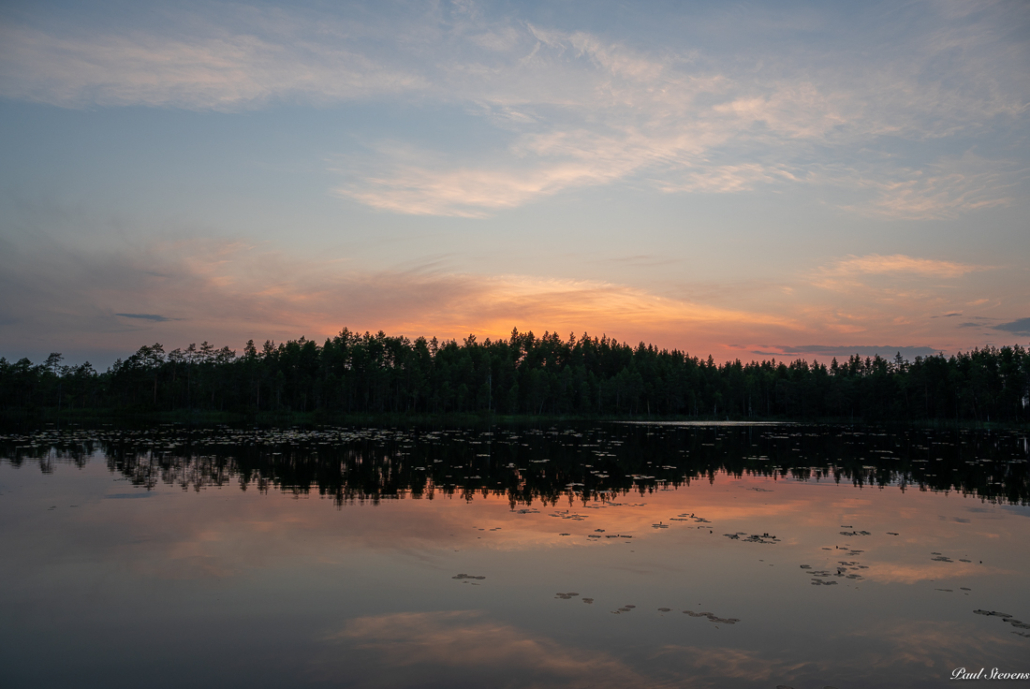
In the evening, when the air has cooled down and after setting up my tent at Sysilampi campsite, I go for a stroll round the circular 4 km long Pakosuo nature trail. In preparation for seeing reindeer, I attach my 70-200 mm lens with a 2x teleconverter to my camera to give more reach. It’s a pleasant route and I see many animals on the way. A wood pipit sits in a small birch just long enough for me to get a photo before flying off.
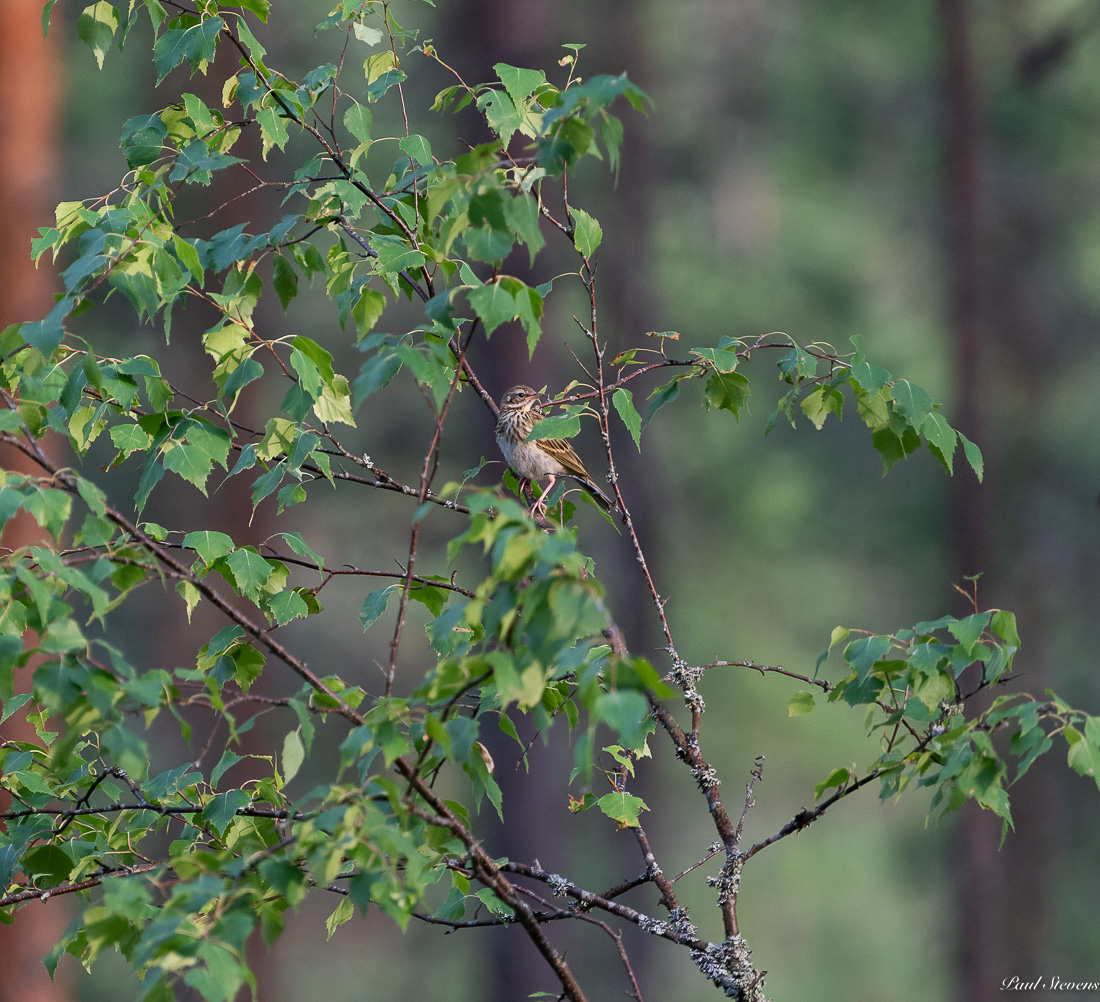
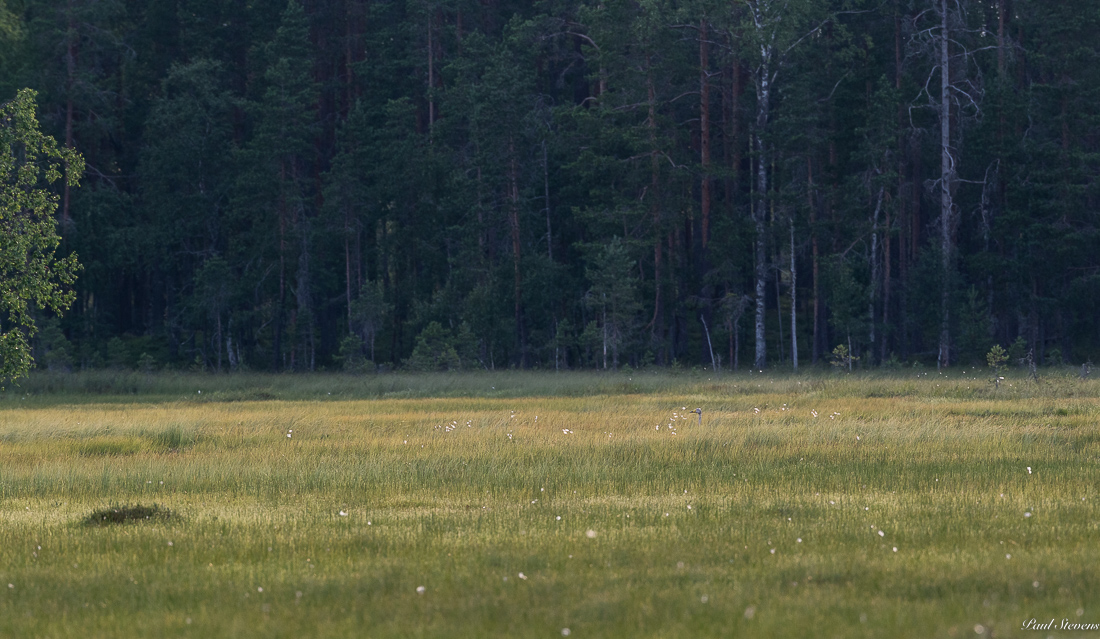
Every time the path crosses a bog, I look carefully in every direction. I see a couple of whooper swans, but not a single reindeer. A tiny lizard runs onto the duckboards. It is very small and dark. For some reason it stops and does not run away. I take a photo before edging closer and lower. The shortest focusing distance with the lens is 1 m which is enough in this case. I wonder for a moment why it didn’t immediately go to the bog like all the other lizards I saw today and yesterday. When the lizard finally leaves the duckboards, I slowly get up and continue my journey.
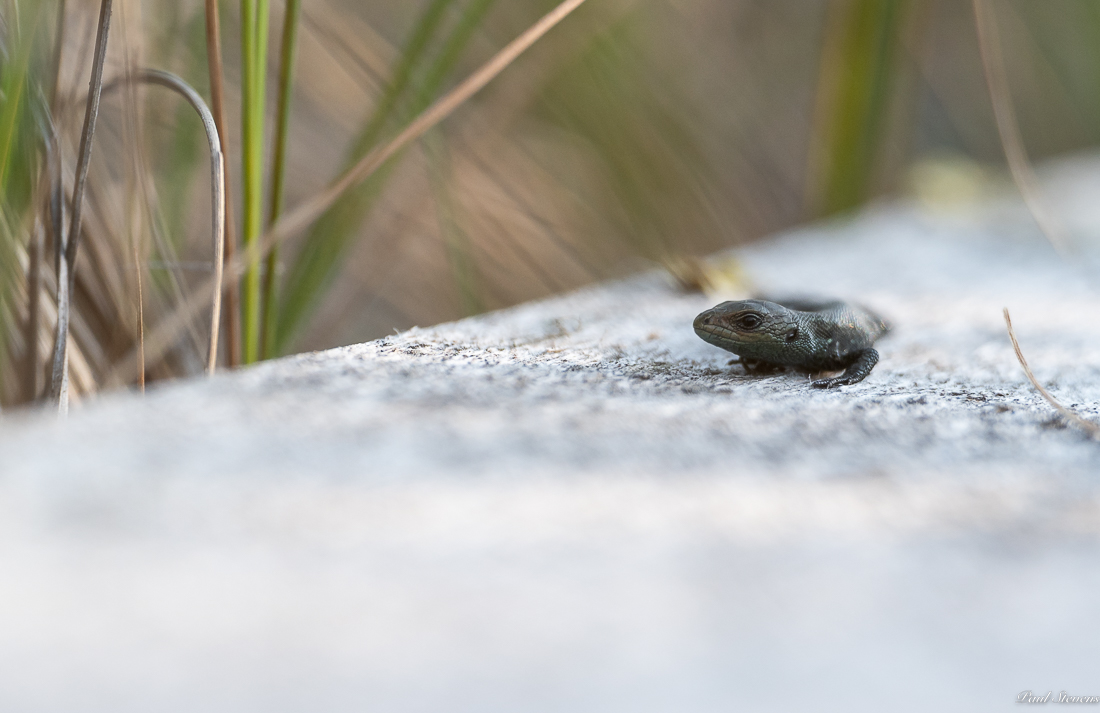
Stepping onto the dirt track to Sysilampi, I imagine seeing a noble bull forest reindeer, with velvet-coated antlers, crossing the track, but it is empty. Some movement catches my eye, a handsome toad sits at the side of the track. I lower my camera as low as possible to get a toad-level shot.

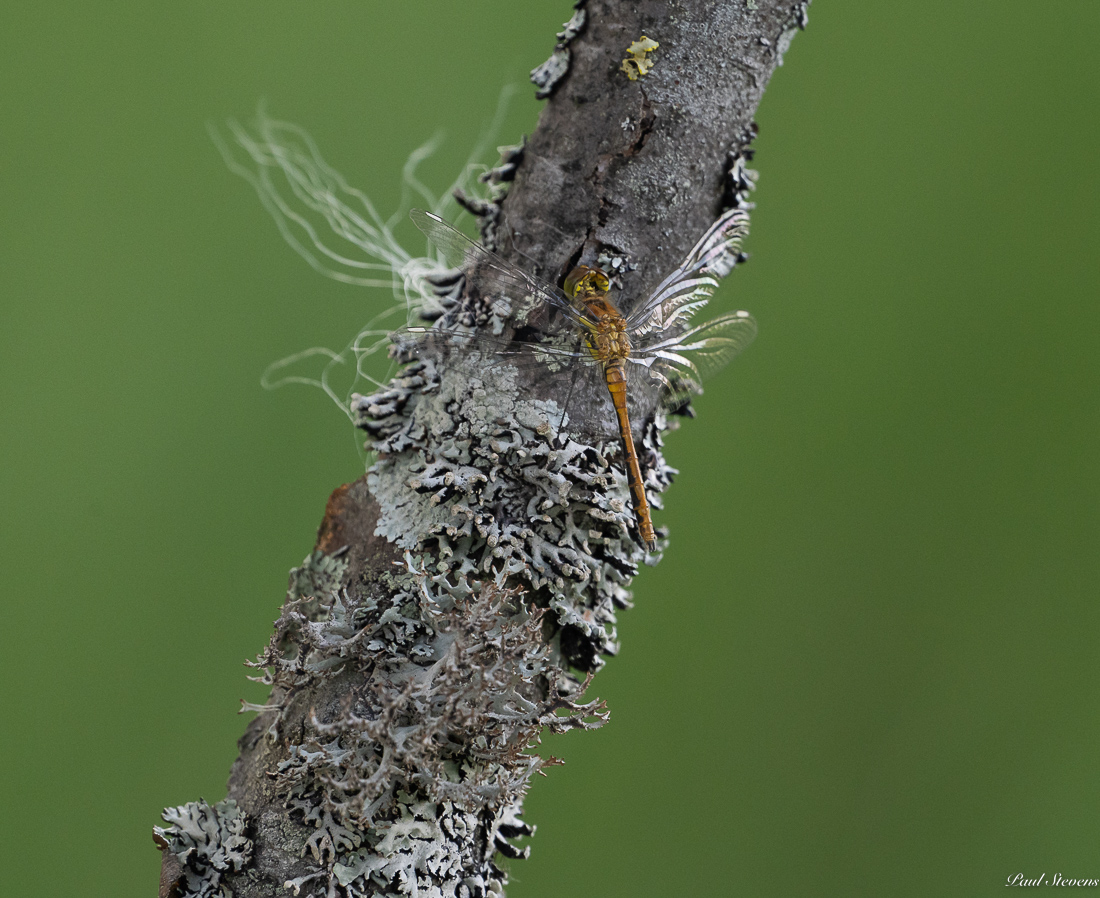
I arrive back at Sysilampi without meeting Petra. After my evening porridge, I sit on the jetty watching the setting sun colourfully paint the sky and its reflection on the calm surface of Syslilampi pond. Tomorrow is a new day which brings new opportunities to finally meet Petra.
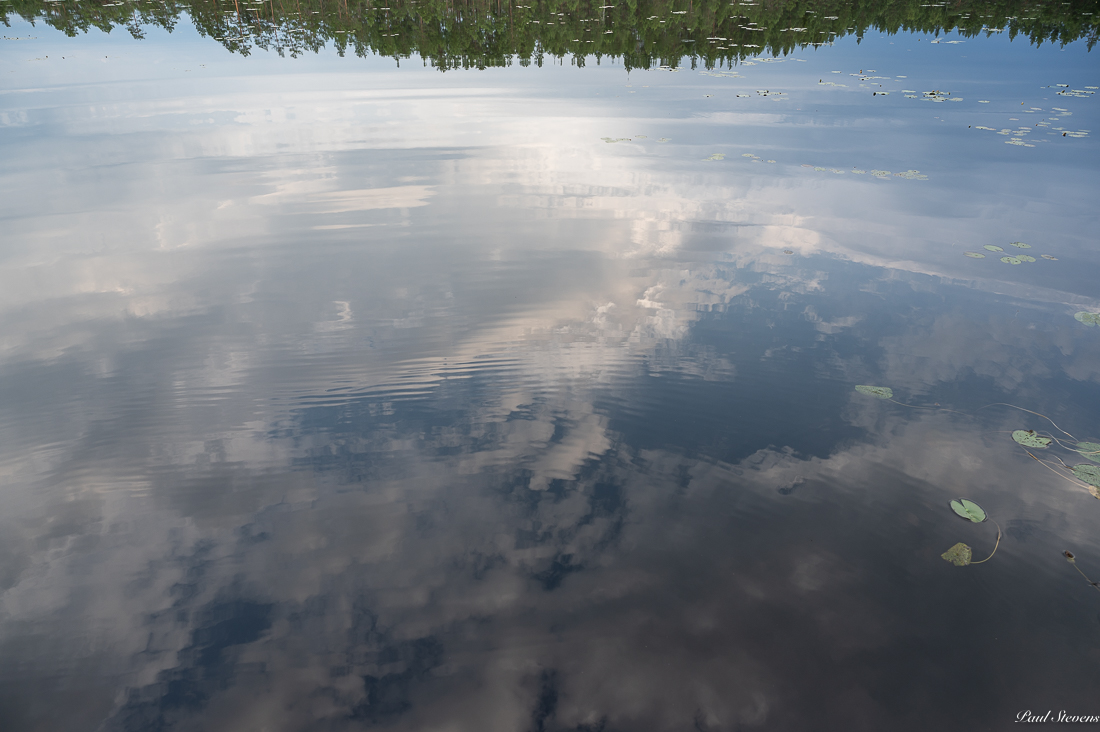
I awake to the muffled sound of distant, rumbling thunder. Light rain patters my tent for a short while. Dark clouds above the opposite shore of the pond move slowly to the north. While enjoying my morning coffee on the jetty, I stare at the reflections of the clouds in the pond. The surface of the pond is almost perfectly mirroring the sky. Staring into the pond, I wonder if my luck will turn today, or whether I will walk the whole way back to my car without even a glimpse of the secretive, mysterious Finnish forest reindeer.
Before 8:00 I am hiking to Koirasalmi, my final destination. I have a little over 10 km and many hours to find Petra. Once again, I cross the quiet and peaceful Pakosuo, looking in every direction for something different, movement, a dark or light spot on the bog. I stop many times but see nothing. For a moment the sky distracts me. The clouds have formed a conveyor belt in the sky. What is it carrying and to where? I continue my journey to the same nature viewing tower without coming up with an answer. There I will have a rest and a snack if nothing else. It is perhaps the only decent chance I have today to see a forest reindeer.
The path goes through forest, where forest reindeer can too easily hide between the trunks, making it easier for them to see me before I spot them. Also, I need to spend too much time watching where I step, because the path is littered with rocks and roots. Sometimes there are duckboards or gravel on top of old duckboards. The gravel makes such a loud noise as I walk that any reindeer has run away long before I would have a chance to see it, should one happen to be nearby of course.
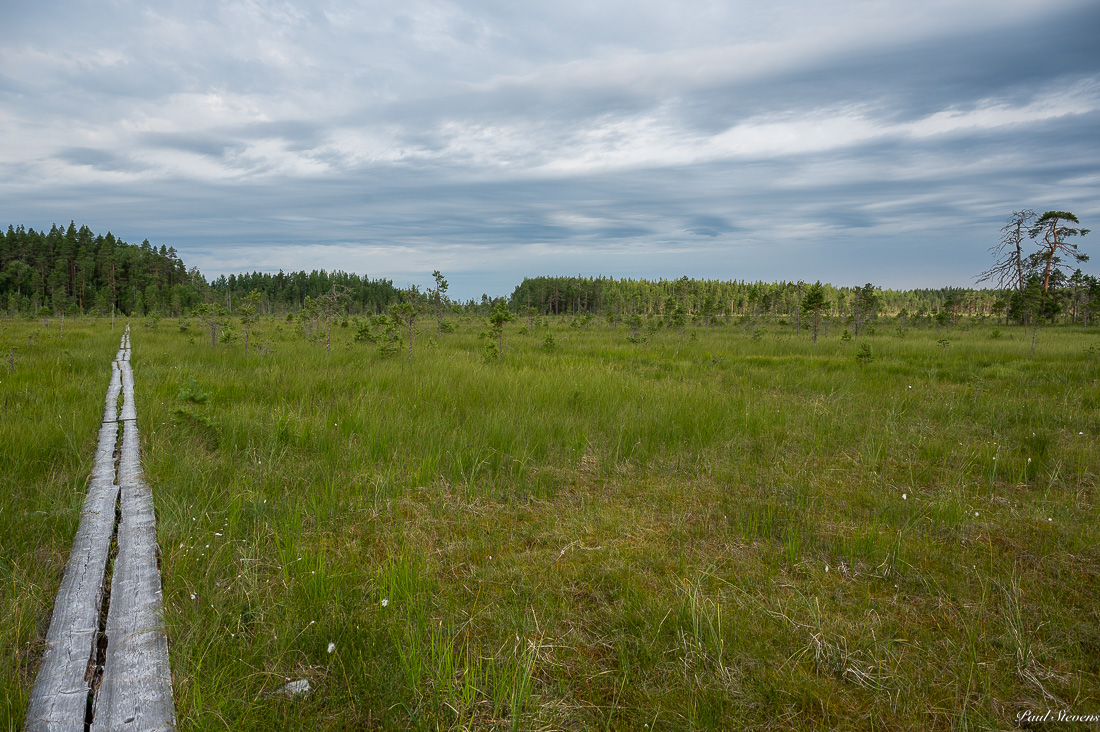
Ahead I glimpse the tower, and beyond it Heikinjärvenneva. The trees thin out as I approach it. Far out on the mire I see a light spot that I’m sure wasn’t there yesterday. As I walked here, I pondered about how I usually have bad luck when looking for a particular animal to photograph. In the winter, I went looking for forest reindeer in another location in Finland, but I didn’t see anything else than their tracks in the snow. Could the light spot possibly be a reindeer? I climb up to the top level of the tower, from where I can see the mire more clearly. Now I’m sure, even though I don’t have binoculars with me. About 150-200 m from the tower, a reindeer is lying down and resting. I don’t know any other pale, large mammal than the forest reindeer or the herded, semi-domestic reindeer. It is unlikely to be semi-domestic reindeer, because Salamajärvi is some distance south of the reindeer herding area. I quickly attach the 400 mm lens combination to my camera. Now I can clearly see a female forest reindeer lying on the mire. She is not alone either, she has her calf with her. I can’t believe what I am seeing with my own eyes. I take a photo and zoom into it on the camera’s screen. Yes, for sure it is a cow and her small, young calf. The cow’s new, growing antlers are clearly visible and she is shedding her winter coat. Totally unbelievable! I have, literally, found Petra and her calf of this year on a mire in a 65 km2 national park. How much better could it have been? Two forest reindeer resting serenely on a mire on a beautiful summer’s day. I take more photos to calm myself down.
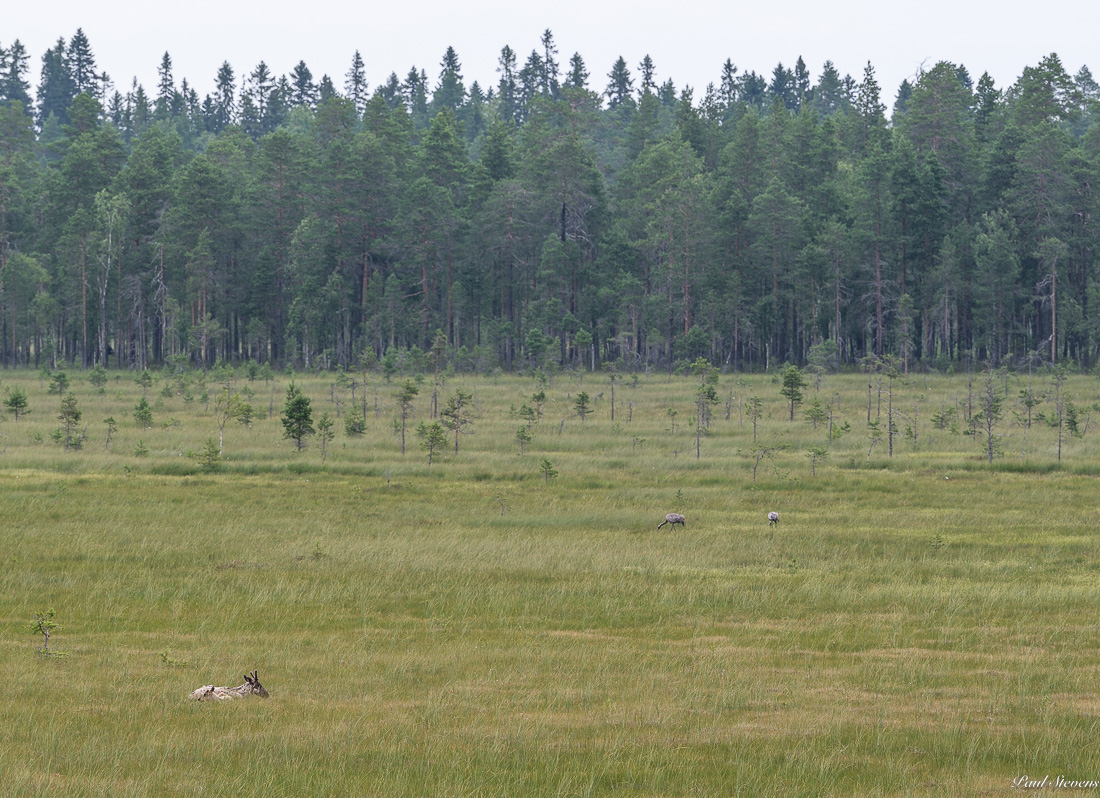
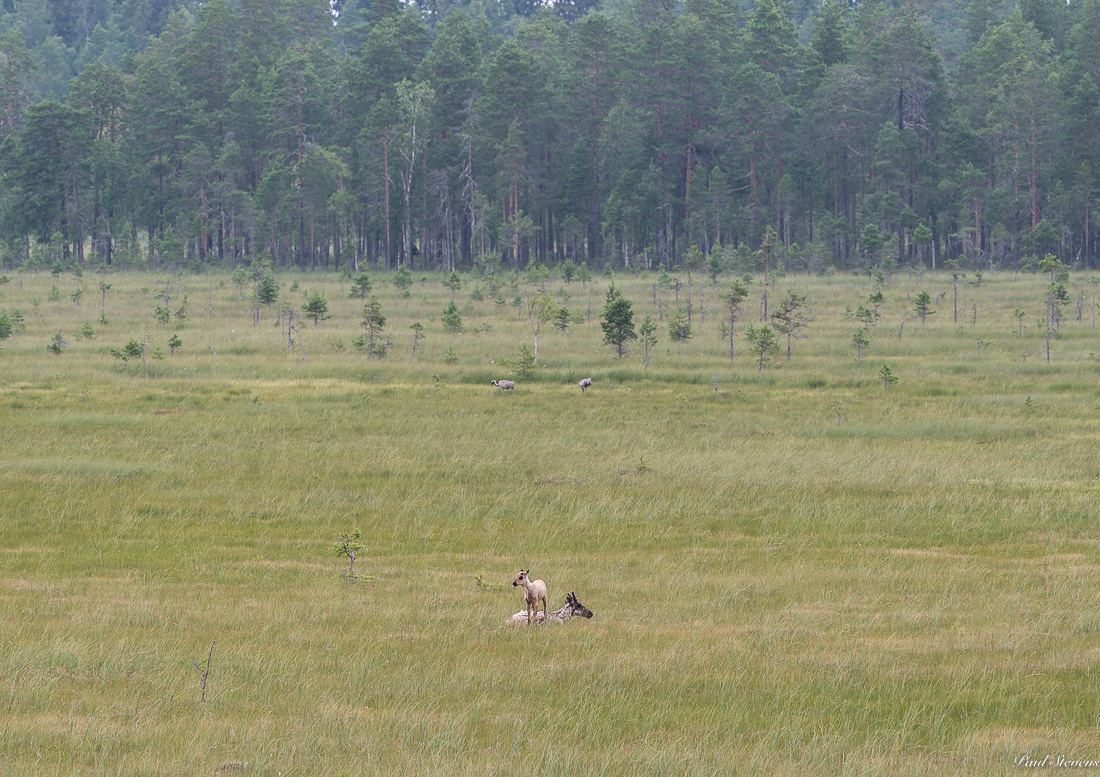
The calf stands up and looks around the mire. Seeing nothing interesting, it drops back to the ground. Far behind them, a pair of cranes call out occasionally, between which they eat. The atmosphere is tranquil, wilderness-like. I sit on the bench in the tower, enjoying the activities of cranes and reindeer. I take the long zoom off and attach my standard 24-70 mm lens to the camera to photograph the landscape. In landscape photos it is easier to see how big the mire is and how small the reindeer are. Suddenly the cow stands up, walks a short distance, and eats some grass or sedges. The calf gets up too and walks towards its mum. Both are eating plenty of tender vegetation, sometimes walking between patches, sometimes raising their heads to check for danger. The swamp stays still and quiet. Nothing moves but the forest reindeer and cranes.
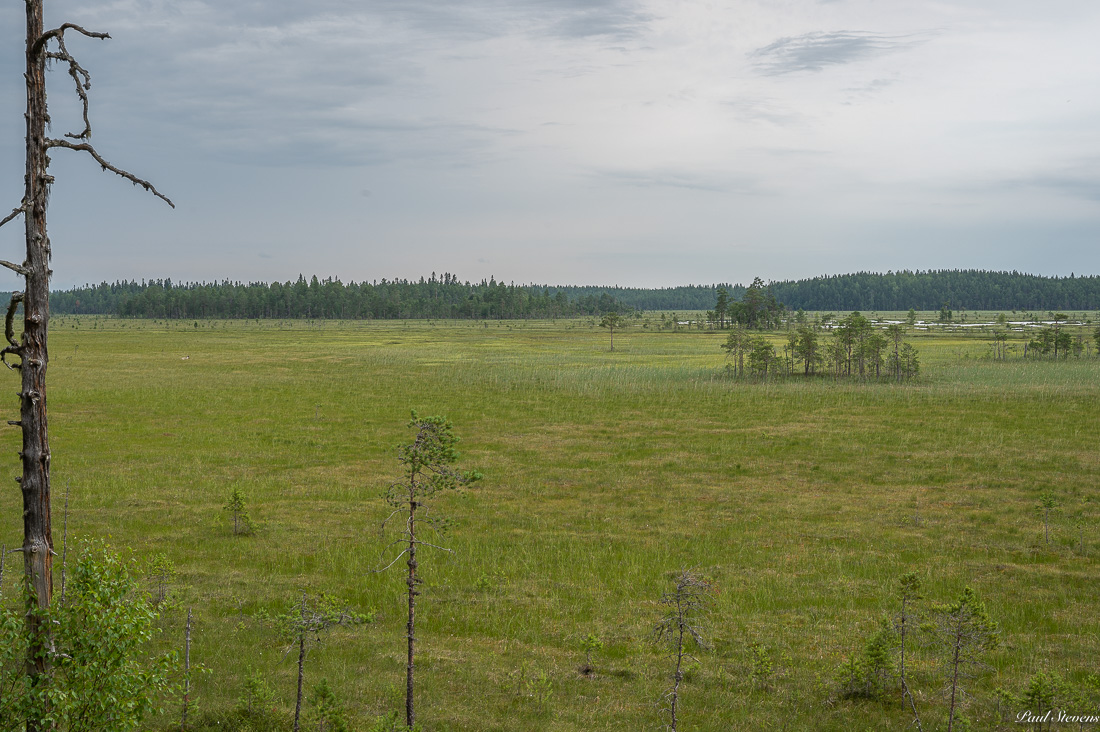
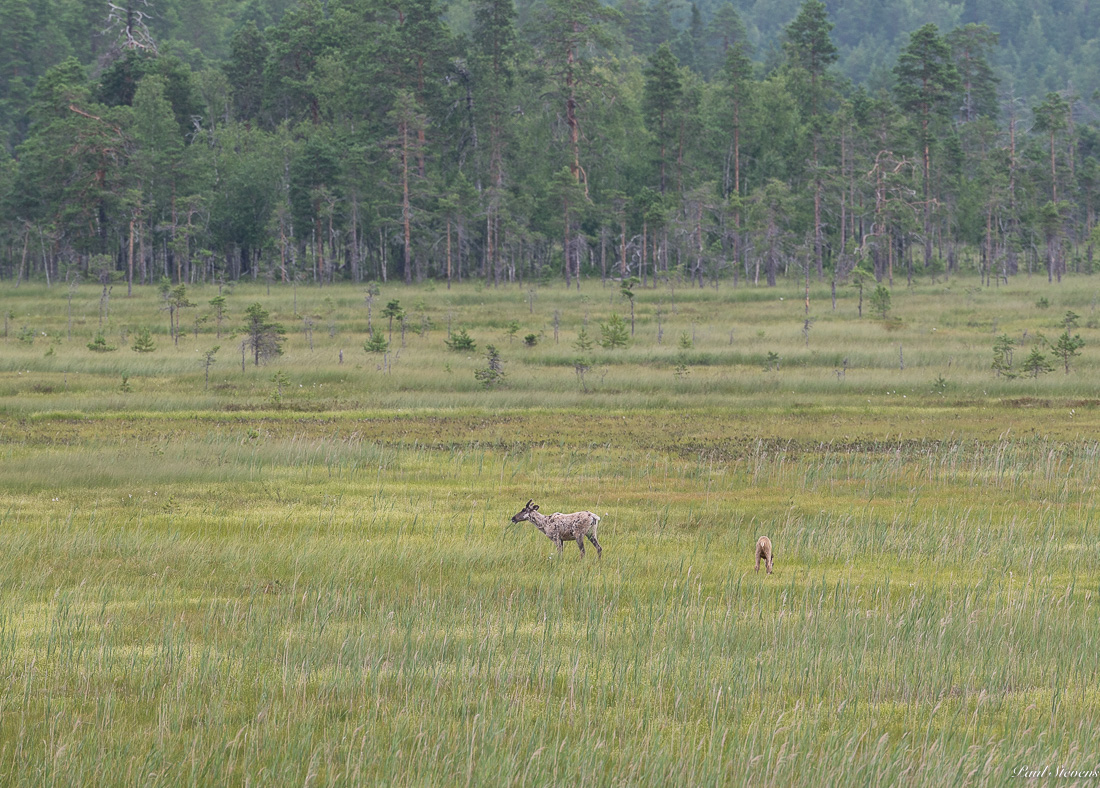
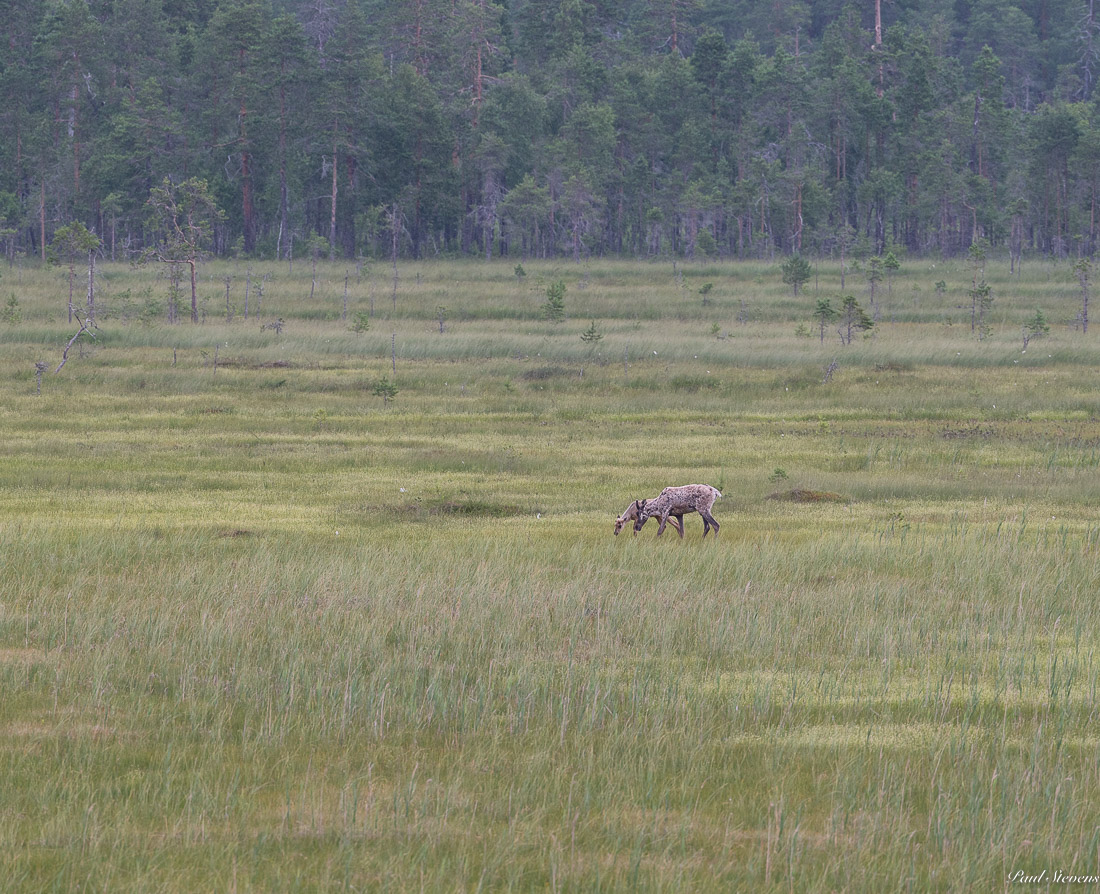
I follow their movements on the mire. The reindeer stay about 150 m from the edge between the forest and mire. I wonder if I could go down safely without disturbing them. There are many trees of different heights at the edge and behind me is a dark forest. I am wearing a grey t-shirt, and dark grey trousers. If I stay still behind the treeline, I should be able to watch them from ground level. It is generally believed that deer cannot see another animal or a person that stays still, but they will notice if the animal or person moves. However, their senses of hearing and smell are much more sensitive than ours. I descend the stairs slowly and carefully, sometimes looking at the mire to see where the reindeer are, and sometimes at my feet. I walk slowly and silently to a suitable place just behind the trees on the border between mire and forest. Standing in the shelter of the trees with dark spruce forest behind me, I take some photos and follow the antics of the small family. Slowly the reindeer amble closer to me all the time looking for tastier morsels. Clearly, my hiding place is working.
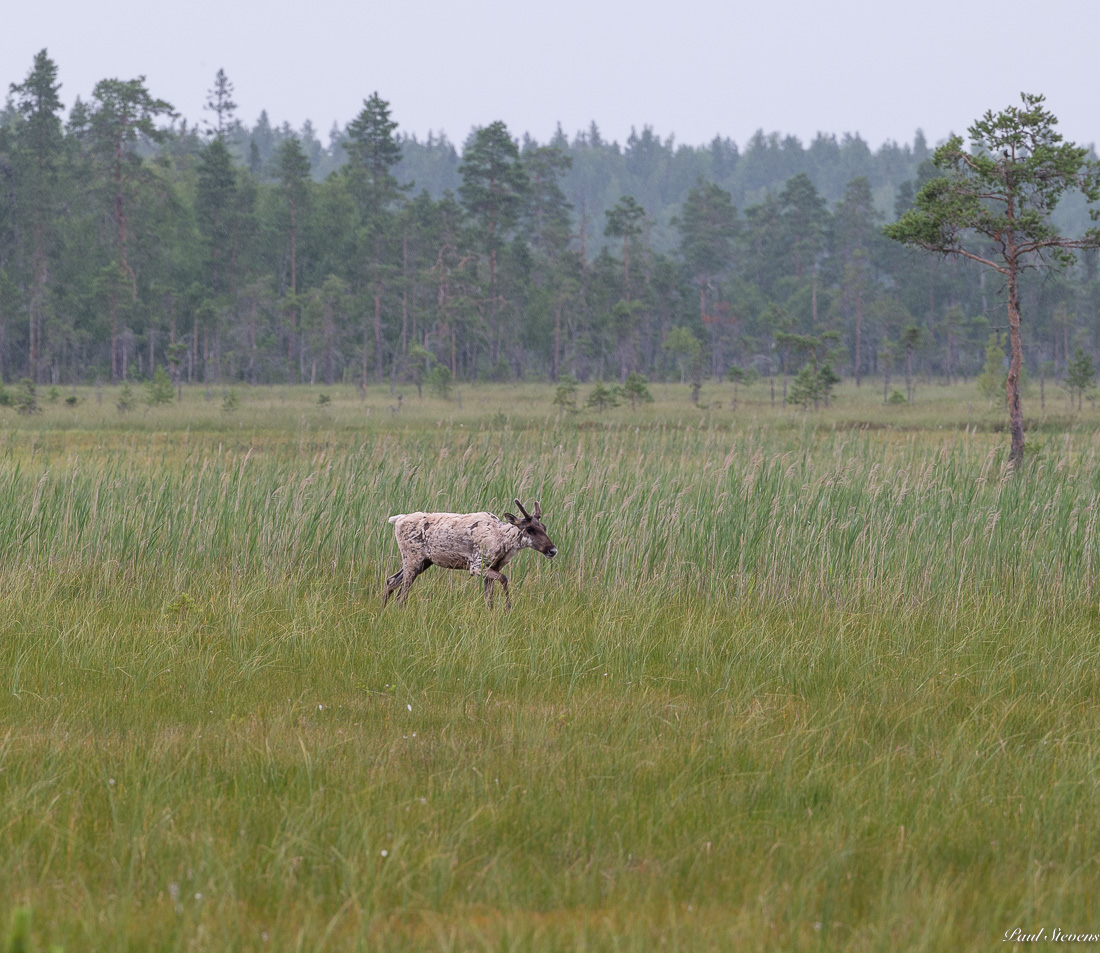
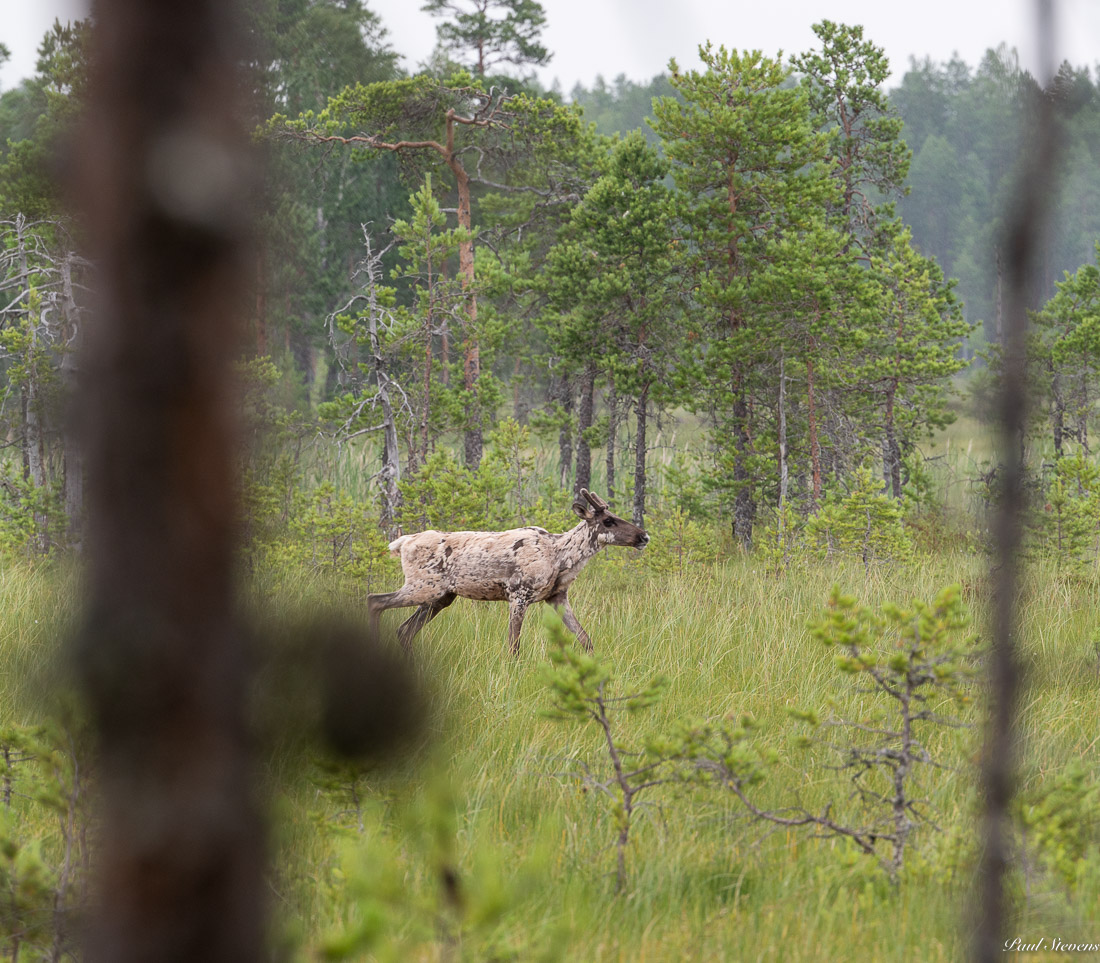
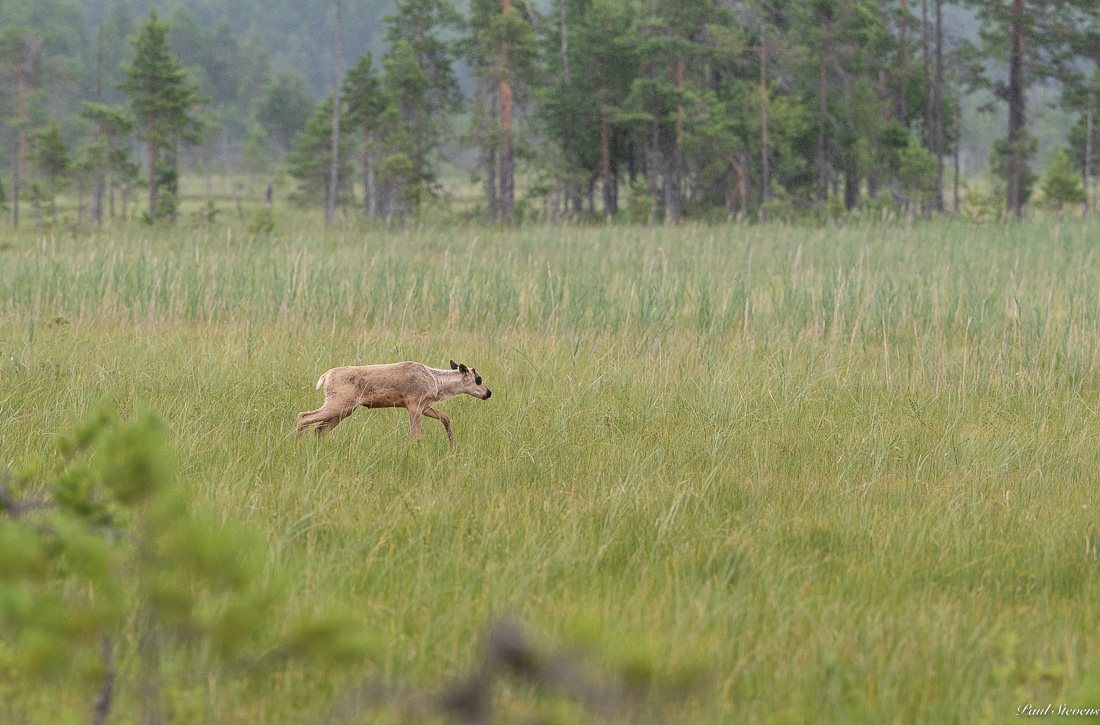
The reindeer family wander away wanting to find and to eat only the freshest and juiciest plants. Mum raises her head and looks across the swamp to the left of where I’m standing. I stay still. Something has caught her attention. The calf continues to eat. Mum goes back to eating and gradually cow and calf walk to a new place. Again, the cow raises her head. Does she hear something? Now it’s important for me to stay quiet, so as not to attract her attention. She faces the same direction as before. Something has caught her attention for sure. Are there other hikers on the trail? Perhaps mum has heard the footsteps of the hikers on the gravel path. She decides that there is some kind of danger and so trots to my right. The calf follows her. They move so easily and lightly over the wet mire. They stop, and after a short inspection of their surroundings, they start eating. Now they are in a place where I can see them, but I can’t get a good photo without moving towards them. I don’t want to do that, so I decide to carefully go back to the tower from where I see them go into the forest.
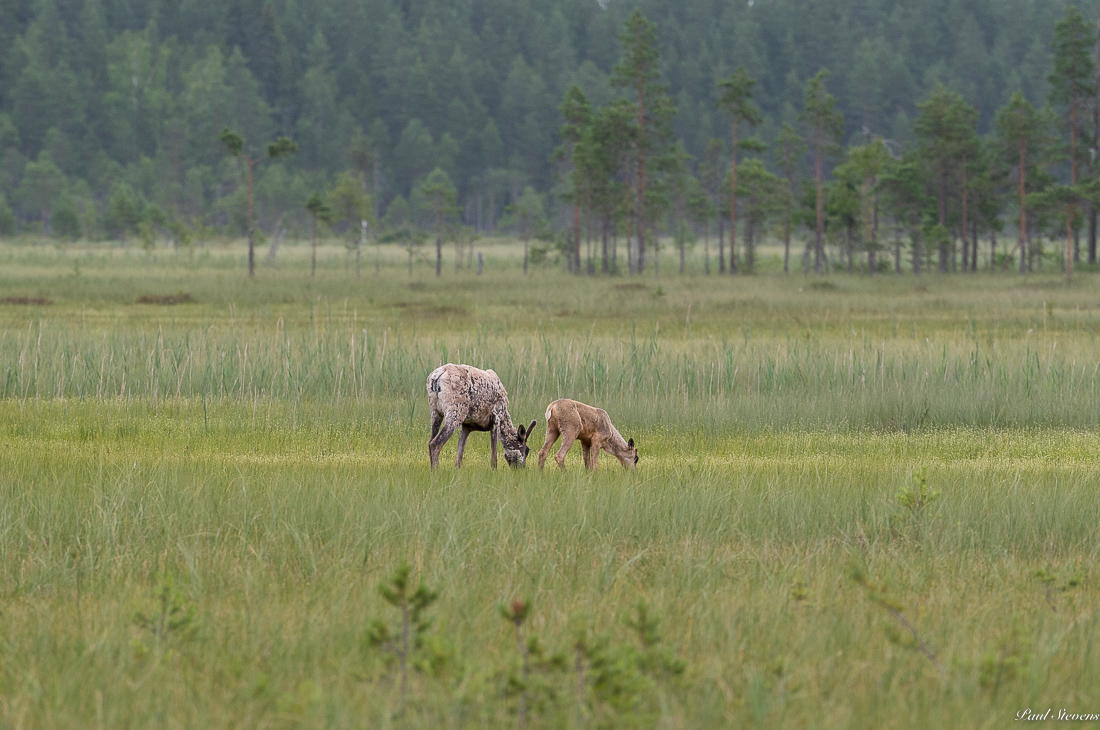
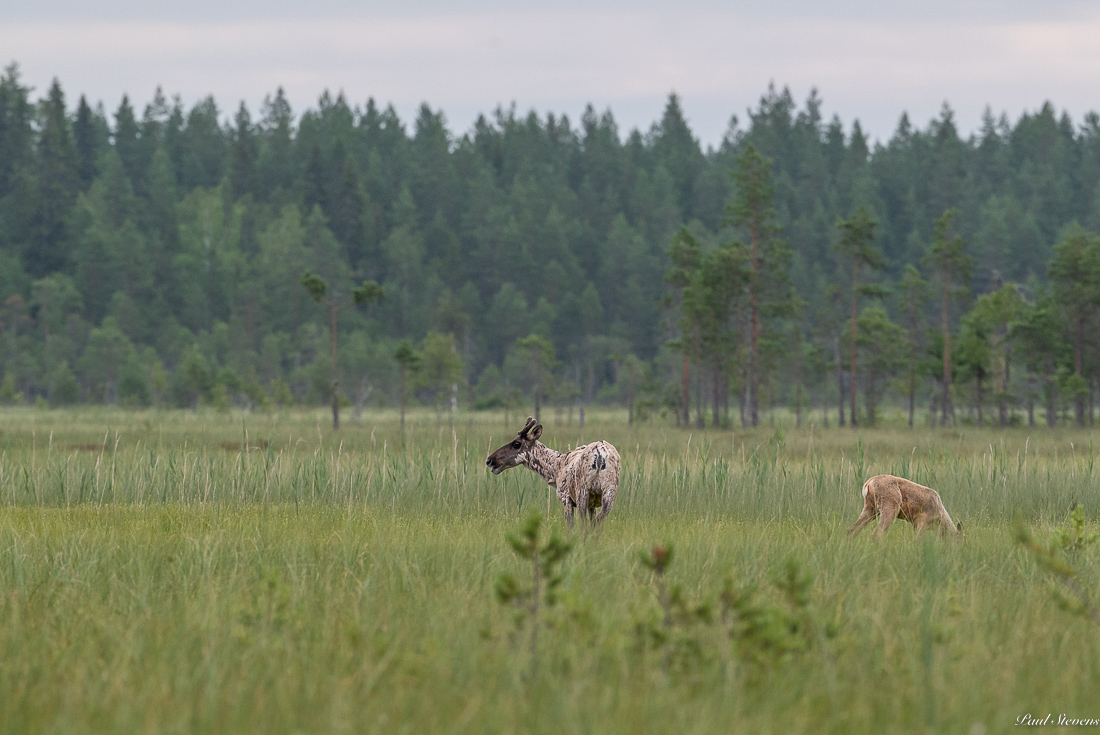
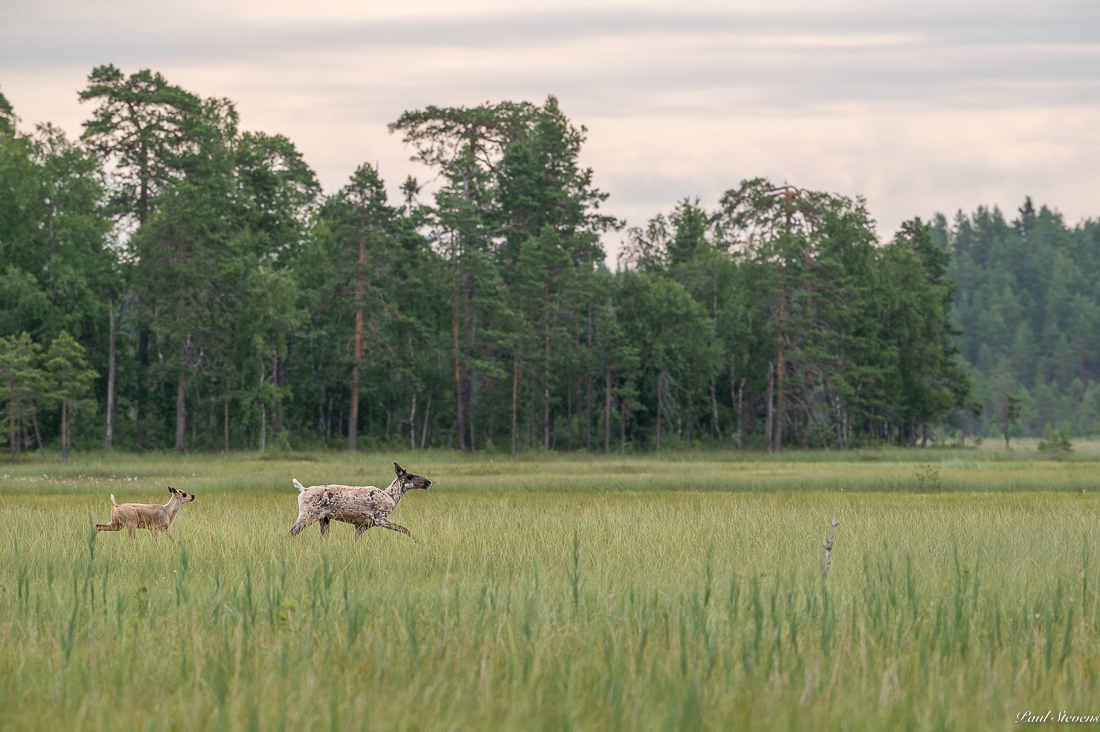
Looking at the photos from my camera’s screen, I see that I spent about an hour in their company. What an amazing experience. Much, much more than I expected. They came within 50-100 m of my hiding place before trotting away. I didn’t expect that. All I expected was just a glimpse of a forest reindeer before it noticed me and ran away into the forest. But it didn’t happen that way. I got to observe the behaviour of the cow and calf for one whole hour. I saw how the mother listened the whole time while they were feeding. She was aware of her surroundings and immediately noticed something unusual, even though I didn’t hear any sound. I will never forget this precious hour with Petra and her calf. After calming down and eating lunch, I put my rucksack on my back, go down the stairs and continue my hike.

With light steps and a happy mind, I walk the remaining 6 km to Koirasalmi through beautiful, varied landscapes. After a rest at Heikinjärvi, I walk over and through many large broken, rock fields. During the final stage, when my legs start to get tired again, the terrain becomes more undulating and demanding. The path is again littered with rocky traps causing me look down more than I would like to avoid tumbling to the ground. At Koirasalmi a cold wind is blowing across the lake, even though it was completely calm a couple of hours ago. All in all, it was a successful, enjoyable 35 km hike in the landscape of Salamajärvi. The most exquisite part of the hike was the hour I spent with Petra and her calf. I hope the photos are good and I haven’t messed them up with all the excitement I experienced.
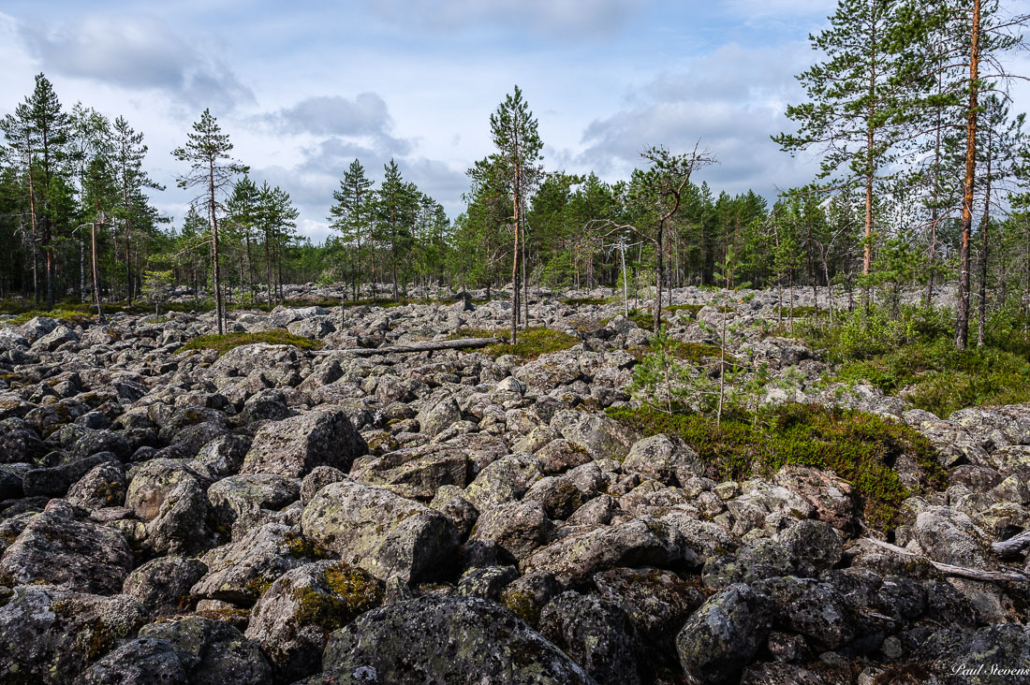
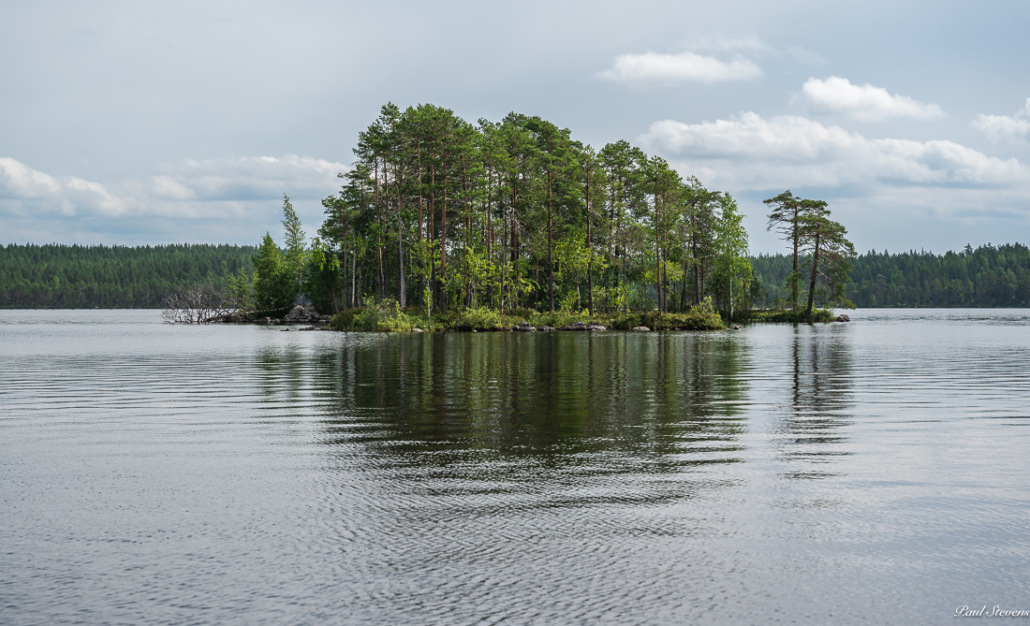

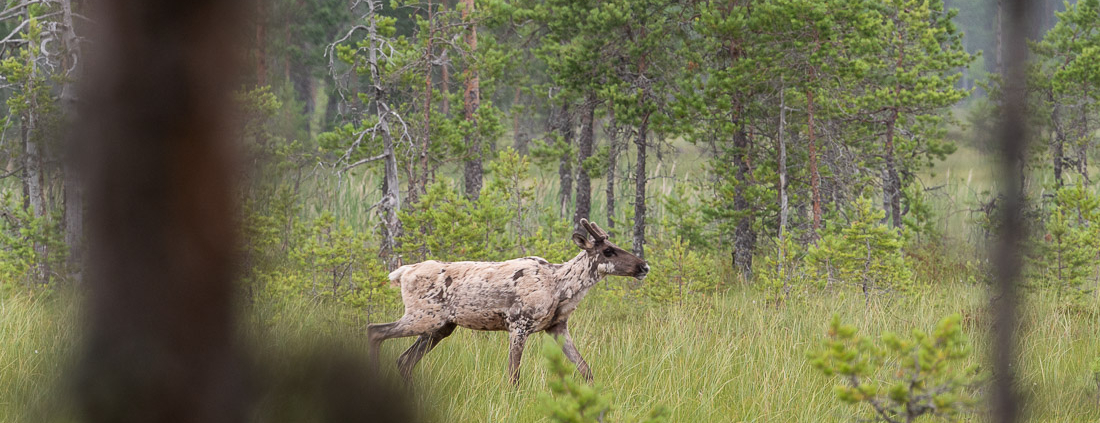



Leave a Reply
Want to join the discussion?Feel free to contribute!